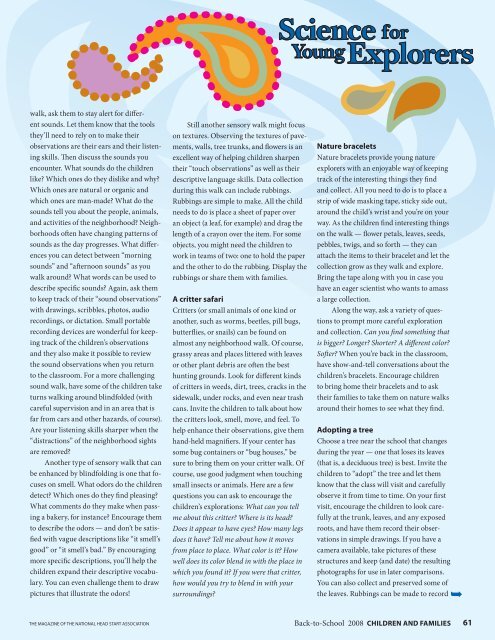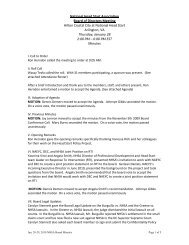New! - National Head Start Association
New! - National Head Start Association
New! - National Head Start Association
You also want an ePaper? Increase the reach of your titles
YUMPU automatically turns print PDFs into web optimized ePapers that Google loves.
walk, ask them to stay alert for di erent<br />
sounds. Let them know that the tools<br />
they’ll need to rely on to make their<br />
observations are their ears and their listening<br />
skills. en discuss the sounds you<br />
encounter. What sounds do the children<br />
like? Which ones do they dislike and why?<br />
Which ones are natural or organic and<br />
which ones are man-made? What do the<br />
sounds tell you about the people, animals,<br />
and activities of the neighborhood? Neighborhoods<br />
o en have changing patterns of<br />
sounds as the day progresses. What di erences<br />
you can detect between “morning<br />
sounds” and “a ernoon sounds” as you<br />
walk around? What words can be used to<br />
describe speci c sounds? Again, ask them<br />
to keep track of their “sound observations”<br />
with drawings, scribbles, photos, audio<br />
recordings, or dictation. Small portable<br />
recording devices are wonderful for keeping<br />
track of the children’s observations<br />
and they also make it possible to review<br />
the sound observations when you return<br />
to the classroom. For a more challenging<br />
sound walk, have some of the children take<br />
turns walking around blindfolded (with<br />
careful supervision and in an area that is<br />
far from cars and other hazards, of course).<br />
Are your listening skills sharper when the<br />
“distractions” of the neighborhood sights<br />
are removed?<br />
Another type of sensory walk that can<br />
be enhanced by blindfolding is one that focuses<br />
on smell. What odors do the children<br />
detect? Which ones do they nd pleasing?<br />
What comments do they make when passing<br />
a bakery, for instance? Encourage them<br />
to describe the odors — and don’t be satis-<br />
ed with vague descriptions like “it smell’s<br />
good” or “it smell’s bad.” By encouraging<br />
more speci c descriptions, you’ll help the<br />
children expand their descriptive vocabulary.<br />
You can even challenge them to draw<br />
pictures that illustrate the odors!<br />
Still another sensory walk might focus<br />
on textures. Observing the textures of pavements,<br />
walls, tree trunks, and owers is an<br />
excellent way of helping children sharpen<br />
their “touch observations” as well as their<br />
descriptive language skills. Data collection<br />
during this walk can include rubbings.<br />
Rubbings are simple to make. All the child<br />
needs to do is place a sheet of paper over<br />
an object (a leaf, for example) and drag the<br />
length of a crayon over the item. For some<br />
objects, you might need the children to<br />
work in teams of two: one to hold the paper<br />
and the other to do the rubbing. Display the<br />
rubbings or share them with families.<br />
A critter safari<br />
Critters (or small animals of one kind or<br />
another, such as worms, beetles, pill bugs,<br />
butter ies, or snails) can be found on<br />
almost any neighborhood walk. Of course,<br />
grassy areas and places littered with leaves<br />
or other plant debris are o en the best<br />
hunting grounds. Look for di erent kinds<br />
of critters in weeds, dirt, trees, cracks in the<br />
sidewalk, under rocks, and even near trash<br />
cans. Invite the children to talk about how<br />
the critters look, smell, move, and feel. To<br />
help enhance their observations, give them<br />
hand-held magni ers. If your center has<br />
some bug containers or “bug houses,” be<br />
sure to bring them on your critter walk. Of<br />
course, use good judgment when touching<br />
small insects or animals. Here are a few<br />
questions you can ask to encourage the<br />
children’s explorations: What can you tell<br />
me about this critter? Where is its head?<br />
Does it appear to have eyes? How many legs<br />
does it have? Tell me about how it moves<br />
from place to place. What color is it? How<br />
well does its color blend in with the place in<br />
which you found it? If you were that critter,<br />
how would you try to blend in with your<br />
surroundings?<br />
Science for<br />
Young Explorers<br />
Nature bracelets<br />
Nature bracelets provide young nature<br />
explorers with an enjoyable way of keeping<br />
track of the interesting things they nd<br />
and collect. All you need to do is to place a<br />
strip of wide masking tape, sticky side out,<br />
around the child’s wrist and you’re on your<br />
way. As the children nd interesting things<br />
on the walk — ower petals, leaves, seeds,<br />
pebbles, twigs, and so forth — they can<br />
attach the items to their bracelet and let the<br />
collection grow as they walk and explore.<br />
Bring the tape along with you in case you<br />
have an eager scientist who wants to amass<br />
a large collection.<br />
Along the way, ask a variety of questions<br />
to prompt more careful exploration<br />
and collection. Can you nd something that<br />
is bigger? Longer? Shorter? A di erent color?<br />
So er? When you’re back in the classroom,<br />
have show-and-tell conversations about the<br />
children’s bracelets. Encourage children<br />
to bring home their bracelets and to ask<br />
their families to take them on nature walks<br />
around their homes to see what they nd.<br />
Adopting a tree<br />
Choose a tree near the school that changes<br />
during the year — one that loses its leaves<br />
(that is, a deciduous tree) is best. Invite the<br />
children to “adopt” the tree and let them<br />
know that the class will visit and carefully<br />
observe it from time to time. On your rst<br />
visit, encourage the children to look carefully<br />
at the trunk, leaves, and any exposed<br />
roots, and have them record their observations<br />
in simple drawings. If you have a<br />
camera available, take pictures of these<br />
structures and keep (and date) the resulting<br />
photographs for use in later comparisons.<br />
You can also collect and preserved some of<br />
the leaves. Rubbings can be made to record<br />
THE MAGAZINE OF THE NATIONAL HEAD START ASSOCIATION Back-to-School 2008 CHILDREN AND FAMILIES 61




